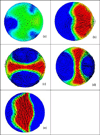Patient-specific bicuspid valve dynamics: overview of methods and challenges
- PMID: 23182904
- PMCID: PMC3552011
- DOI: 10.1016/j.jbiomech.2012.10.038
Patient-specific bicuspid valve dynamics: overview of methods and challenges
Abstract
About 1-2 % of the babies are born with bicuspid aortic valves instead of the normal aortic valve with three leaflets. A significant portion of the patients with the congenital bicuspid valve morphology suffer from aortic valve stenosis and/or ascending aortic dilatation and dissection thus requiring surgical intervention when they are young adults. Patients with bicuspid aortic valves (BAVs) have also been found to develop valvular stenosis earlier than those with the normal aortic valve. This paper overviews current knowledge of BAVs, where several studies have suggested that the mechanical stresses induced on the valve leaflets and the abnormal flow development in the ascending aorta may be an important factor in the diseases of the valve and the aortic root. The long-term goals of the studies being performed in our laboratory are aimed towards potential stratification of bicuspid valve patients who may be at risk for developing these pathologies based on analyzing the hemodynamic environment of these valves using fluid-structure interaction (FSI) modeling. Patient-specific geometry of the normal tri-cuspid and bicuspid valves are reconstructed from real-time 3D ultrasound images and the dynamic analyses performed in order to determine the potential effects of mechanical stresses on the valve leaflet and aortic root pathology. This paper describes the details of the computational tools and discusses challenges with patient-specific modeling.
Copyright © 2012 Elsevier Ltd. All rights reserved.
Conflict of interest statement
We wish to confirm that there are no known conflicts of interest associated with this publication and there has been no significant financial support for this work that could have influenced its outcome.
Figures







References
-
- Antiga L, Piccinelli M, et al. An image-based modeling framework for patient-specific computational hemodynamics. Med Biol Eng Comput. 2008;46(11):1097–1112. - PubMed
-
- Burken JA. Biomedical Engineering. The University of Iowa; 2012. Determining the Effect of Congenital Bicuspid Aortic Valves on Aortic Dissection Using Computational Fluid Dynamics. M.S.
-
- Cecconi M, Manfrin M, et al. Aortic dimensions in patients with bicuspid aortic valve without significant valve dysfunction. Am J Cardiol. 2005;95(2):292–294. - PubMed
-
- Christie GW, Barratt Boyes BG. On stress reduction in bioprosthetic heart valve leaflets by the use of a flexible stent. J Card Surg. 1991;6(4):476–481. - PubMed
-
- Conti CA, Della Corte A, et al. Biomechanical implications of the congenital bicuspid aortic valve: a finite element study of aortic root function from in vivo data. J Thorac Cardiovasc Surg. 2010;140(4):890–896. 896, e891–e892. - PubMed
Publication types
MeSH terms
Grants and funding
LinkOut - more resources
Full Text Sources
Other Literature Sources
Medical

